What is the best social media content strategy?
The best content strategy on social networks in 2023 is called content on content and consists of:
1- Create pillar content: detailed and in-depth texts, audios or videos.
2- Extract pieces of that pillar content and contextualize them for different platforms.
3- Distribute these fragments in various communication channels.
The solution for endless social media content is called content on content and was devised by GaryVee .
This methodology consists of creating or documenting a base content and extracting from it as many fragments as possible for different platforms.
The need to design a new content generation system for RRSS is due to the fact that the main resource sometimes seems to run out.
In addition, it is believed that the only way to organize the creation of publications is by making annoying grids and that the most important thing is not the value of your content, but the layout that the posts will have in the feed.
How do you get the most out of every piece of content you produce? How to feed what Guy Kawasaki in The Art of Social Media calls content monster ?
In the following article, we will explain in detail how content on content works and we will tell you how to put it into practice according to our own experience.
You can also listen to this episode of Pencil Speech, where the topic we discussed is based on this concept as a way to create organic, authentic and valuable content.
What is content on content?
It is a strategy so that every effort invested in creating valuable content is well used.
It consists of creating a base content and extracting as many fragments as possible from it.
What is a base content or pillar content ?
It is any product that you make and that is not initially intended to be used for your social networks.
It can be an article, a YouTube video, a podcast episode, or even the PowerPoint presentation that will accompany you in a presentation.
~
Do you want to improve your presence in the digital world?
We can put you in front of hundreds of potential clients just when they need you.
~
How to make content on content?
Once the base content exists, its most striking parts must be identified.
These segments (text, audio or video) will be cut and distributed on the different social networks.

Gary explains the procedure using an inverted pyramid:
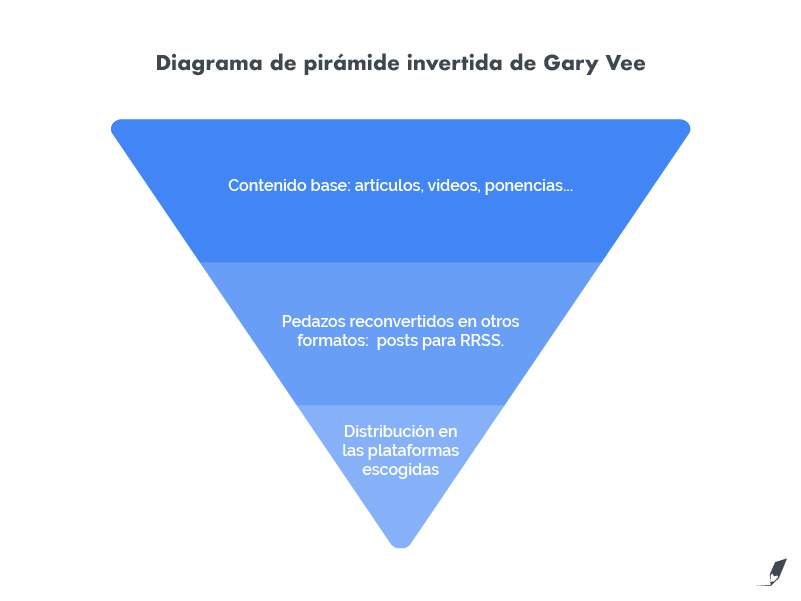
In the following presentation, Gary explains how he pulled over 30 pieces of content from a single talk using content on content:
In 2019, he published another presentation where he gives a step-by-step on how to get more than 60 pieces of content in a single day for different platforms .
Do you want us to help you with your social networks or advertising on Google? Leave us your details and we will contact you!
Steps to make content on content: the best social media strategy
1. Focus your energies on creating valuable base content. Write the most in-depth articles on the web, produce the best YouTube videos, or record the most nutritious podcast your audience will enjoy.
2. Document any occasion in which you are going to talk about your product or service. You can also record in-office or virtual conversations on topics related to your industry.
3. Extract and contextualize text or video fragments that are meaty. Each segment can have different target audiences and platforms. The important thing in this step is to contextualize it so that it works as native content where it is going to be published.
4. Program the new posts in your brand accounts , according to your experience and the statistics of each social network.
As an example, we will explain how we execute this methodology in Pencil Speech:
Create content for Facebook and LinkedIn
From the articles that we publish on our blog , we extract fragments that can be read independently.
Each of these chosen sections is contextualized so that they can be understood without the rest of the text.
The new formulations are what we finally post on LinkedIn and Facebook.
At the end of the excerpt, we insert the link to the article: that way, your featured image will accompany the link:
Create content for Twitter
Creating content for Twitter is similar to that for Facebook and LinkedIn:
It is based on extracting text fragments that work independently of the entire article and then publishing them on the social network in question.
The catch here is that those snippets will be, at most, two sentences long.
It is essential that parts of the text be chosen that are as clear as they are brief and substantial.
In addition, many times we do not include a link to the article on our website because it is aggressive in such a short space to give the message.
Imagínate aparecer al frente de tu consumidor justo cuando ellos te necesitan.
— Pencil Speech (@PencilSpeech) December 3, 2020
¿Magia?
No, SEO.
Create content for Instagram (images, illustrations and photos)
In Pencil pillar content, self-images are common:
As we write the articles, we also produce designs that complement them. An example of this is the pyramid used above.
For the content on content, we adjust its dimensions to the correct ones for Instagram and it only remains to write the caption.
Likewise, Instagram posts with multiple images work for creating Slideshare presentations.
In this way, another platform is attacked and the carousel can be embedded in WordPress as part of the article.
You can review our guide to managing Instagram successfully to read recommendations for the frequency of publication on this network and tips to achieve the desired goal with each post.
Create content on Quora (questions and answers)
One of the advantages of Inbound Marketing is appearing in front of people just when they are looking for you.
This is how Quora works: it connects people and experts interested in the same topic.
What is this about content on content?
We, to continue making the most of our articles, look for questions on the platform that can be answered with the content we have already created.
For example, if in an article we explain why we believe that SEO is the most powerful marketing tool , we can answer questions such as:
– Is it worth investing in SEO?
– Which marketing strategy is better in 2019?
– What is better between SEO and SEM?
And so on.
In addition to offering timely information to people who require it, our brand gains visibility and backlinks on a new platform.
Create content for YouTube (videos)
With the video format, another level of content on content is unlocked.
We do it in the following way:
With the information of each article, we recorded a video .
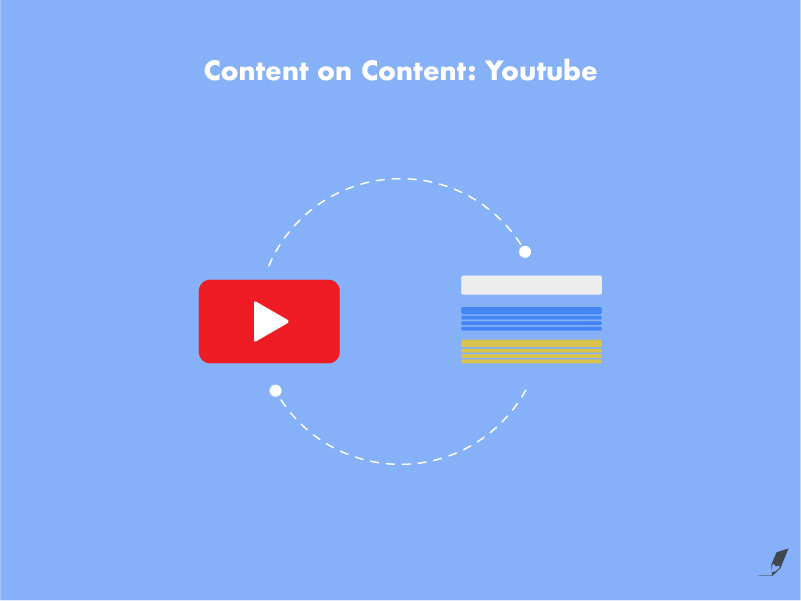
This audiovisual material is hosted on YouTube , where, in turn, it will redirect to the text on the web.
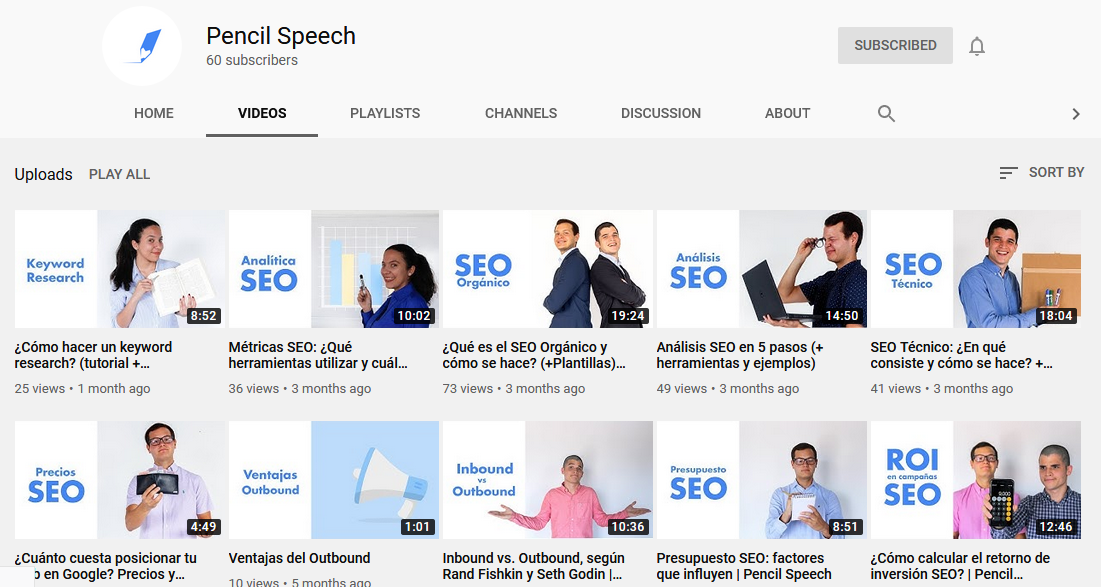
At the beginning of the blog entry, the video is also embedded so that it adds to the views on YouTube.
From the video, as well as from the articles, we extract pieces that work independently.
That is, the video itself becomes a new pillar content.
Then those bits are posted on Instagram, Facebook and LinkedIn.
Create content from presentations and keynotes
Every time we attend an event or give a workshop, we take advantage of this opportunity to nurture our content bank.
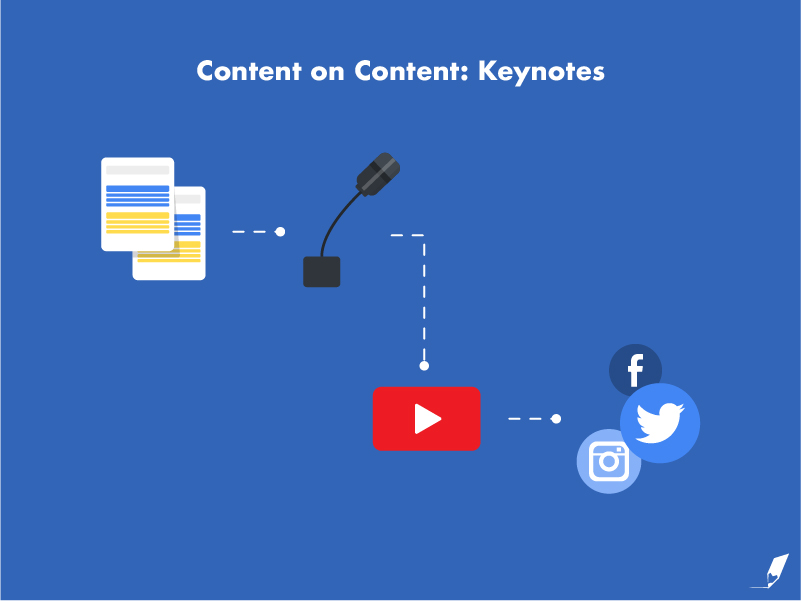
Being a new occasion, it is worth recording it and uploading it to YouTube.
As with the other videos, you can take advantage of not only the recording of the entire event (base content or pillar), but also short fragments that serve isolated from their context.
Events, whether virtual or face-to-face, are also a valuable moment from which human , natural and immediate content can be extracted.
How to take advantage of human resources?
We have found that posts about us, compared to those about our service (SEO), are much more attractive to those who follow us.
Perhaps we are talking about our history or an element of our brand, but it is important to get the most out of human resources to connect with others and remind them that behind any great structure there are people working every day.
What platforms to use to schedule posts on social networks?
Now that we explain what content on content is and how we apply GaryVee’s inverted pyramid structure, let’s move on to the tools we use to schedule posts for each network.
According to what has worked best for us in the past, we set the day and time of publication for each content in an editorial calendar.
Here we leave you a very useful illustrated article from which we start to establish our publication frequency.
Then, we make the posts as follows:
On its own platform, Facebook allows you to program content. All you have to do is click the arrow next to the “Publish” button and choose “Schedule”. It is advisable to avoid linking to an external tool if Facebook gives us this advantage.
To schedule posts that don’t contain videos, we use Postfity .
The limitation is because our account is free. In case of containing a video, the publication is made manually by entering LinkedIn at the time we want to share it.
Twitter, like Facebook, lets you schedule tweets within its platform.
The only requirement is to enter the social network from the computer and you will have the Programming option available:
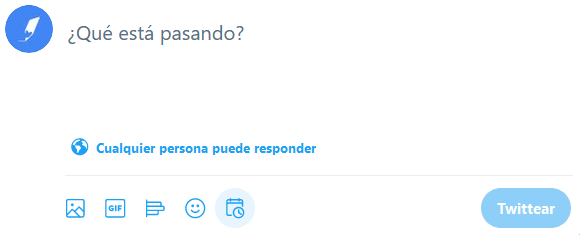
Due to the application programming interface (API) of the social network, programming content from Instagram was not possible.
However, now you can with Facebook Creator Studio .
In order to use this tool, the Instagram profile must be business.
Once both accounts are connected, there you will be able to see statistics of previous posts and stories, in addition to scheduling future posts without any limitation.
What have been our results using content on content?
In our article on how to attract web traffic , we explain:
Let’s see, we have been active in our networks.
We have delivered content and engaged with our community.
Basically, we have had a lot of fun and we are happy with our results, because the work that the networks have done has been framed in the objectives that we set for them:
-Brand recognition.
-Exposition.
-Followers.
-Interaction with other companies.
-Community development.
When comparing our social media strategy with the SEO efforts we have made, we can conclude that it is more valuable to be on the first page of Google than to have thousands of interactions in RRSS.
By following this link, you will get the case study on how many users content on content has brought to our website.
You will also be able to read how they behave once on the site and how they differ from those people who have landed on our website from Google.
Final recommendations for making content on content
To ensure that a content on content strategy is successful, you can never forget:
Create native content
It is very important to be careful in the correct contextualization of each content.
As users, we do not like to feel that we are receiving a “rehash” of information programmed by a machine.
So even if the source of an Instagram post is an article, it can’t feel like our sole purpose is to drive people to the website.
On the contrary, the post must feel genuine , born exclusively to exist on Instagram.
Thus, the publication will have more impact and will generate the desired effect among our audience.
Respect the space of each platform
Keep in mind that when a person enters a social network it is with the intention of consuming content there :
We go to Instagram to see photos and videos, waiting for IGTVs, stories and reels.
Not to visit the “link in bio” of each account we follow.
Know the audience of each place
Those who follow you on Quora are not the same as those who follow you on Instagram or Twitter.
Study your community and personalize the content of each social network according to the interests of your followers in it.
Even if you use the same pillar content for all platforms, the fragments to use, the approach you give them and, of course, the format in which you present your information will change.
Look for the “wow”
Don’t get bored. Innovate and don’t become predictable. When users already expect what you are going to publish, their level of interaction drops.
Keep them aware of your new posts and interested in your content.
You can vary the frequency of each type of post, create new series, and play around with the design of your posts until you find a strategy that works perfectly for your business.
Document, don’t create
Although it may not seem like it to us, we are doing and saying interesting things all the time:
With the right structure, it can be very good material for videos that are published on social networks and even YouTube.
What do we mean by structuring?
First of all: to the content .
The conversation has to be interesting and nourishing to be worth turning into something that will be replayed hundreds of times later.
Then onto the stage .
If you will take advantage of meetings or conversations to get content, do not forget to take care of the lighting of the site, the background, the camera frames and the clarity of the audio.
Conclusions
Feeding the content monster is not easy: it takes time and organization.
However, there are more opportunities than you think to extract new pieces of content to help you promote your website, podcast or YouTube channel.
The secret is to figure them out.
Success in your campaign!



